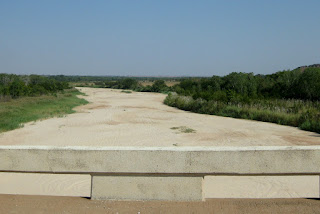 I'm not too big on beer. When I saw that there was going to be a Beer Fest at Riverwind a couple of weeks ago, I was mostly intrigued because of all of the local breweries that were going to be sampling their wares. I had tried a few of the local beers, but since I'm admittedly not big on beer in the first place, it would take forever to sample them all, one pint at a time. This was the perfect opportunity to taste-test a whole slew of Okie-brewed goodness.
I'm not too big on beer. When I saw that there was going to be a Beer Fest at Riverwind a couple of weeks ago, I was mostly intrigued because of all of the local breweries that were going to be sampling their wares. I had tried a few of the local beers, but since I'm admittedly not big on beer in the first place, it would take forever to sample them all, one pint at a time. This was the perfect opportunity to taste-test a whole slew of Okie-brewed goodness. Half a dozen tastes later, I decide I will need to call it quits if I am going to drive home. The event is winding down anyway. That is when I meet "All it takes is a liver and a dream", and we decide that we should take a tour of one of our favorite local breweries - COOP Ale Works.

Fast forward two weeks and we join a handful of people on a rainy Saturday at the unassuming metal building that currently houses the COOP operations (at least until the bank signs a big check and they get to move to a much larger facility on S. Meridian). The small "COOP Ale Works" sticker on the glass of the front door is the only indication that we were at the right place. Co-owner, J.D. Merryweather greets everyone and quickly reminds each of them as they arrive that he isn't allowed to do any tastings, due to current laws. Despite the warning, no one walks out.
 | ||
J.D. explains how beer is first heated in the whirlpools...
|

The tour starts in the front of the warehouse, surrounded by floor-to-ceiling pallets of Horny Toad cans and shelves of different varieties of malt. Jack Daniel whiskey barrels are wheeled in as space allows. We move to the back of the warehouse where whirlpools and giant metal tanks turn simple ingredients into a finely-crafted beverage. Buckets of sterilized water bubble as carbon dioxide is released from the brew in the tanks named after the Jackson 5 (and various other Jackson family, as operations expanded). Alcohol and carbon dioxide are the by-products of the fermentation process, and the tanks can only hold 18 PSI. J.D. shows us where the tedious canning and bottling take place in a small, four-person assembly line. He also explains the difference between ales and lagers, for the beer-illiterate, such as myself.
 |
| Proof that the yeast is doing its job |
 COOP is proud of its local heritage (even though J.D. is originally from Ohio and admits that he has tried to leave Oklahoma on several occasions). They participate in loads of local events and charitable functions. Their website boasts of their focus on being local, sustainable, and high-quality/ low impact. They were one of the first local businesses to be 100% wind-powered. There are future plans to purchase hops grown here in Oklahoma, if the water-hungry crops are successful. In addition, COOP prides themselves on over-doing the customer service side of the business - definitely a plus!
COOP is proud of its local heritage (even though J.D. is originally from Ohio and admits that he has tried to leave Oklahoma on several occasions). They participate in loads of local events and charitable functions. Their website boasts of their focus on being local, sustainable, and high-quality/ low impact. They were one of the first local businesses to be 100% wind-powered. There are future plans to purchase hops grown here in Oklahoma, if the water-hungry crops are successful. In addition, COOP prides themselves on over-doing the customer service side of the business - definitely a plus!
I asked about the COOP logo, since an anvil just isn't the first thing that comes to mind when you think about beer. He explains that they are one of the few breweries that still brew in wooden barrels, which were hand-crafted with anvils. The COOP name comes from a combination of a "coop"eration between the group of friends that started the company as well as the number of "co-op's" around Oklahoma and neighboring states. While some of the beer label art is self-explanatory (Horny Toad, DNR, F5, and Native Amber), some of the others are a little more personal. The Gran Sport Porter features a vintage Vespa, that was one of the 30 Vespas that he owned at one point. ("Why 30?" I ask. "Because I didn't have room for 31," he answers.)
Even though the current shop seem tiny in comparison to most brewing operations, it is exciting to see what this company has done in 3 1/2 years. Oklahoma is now one of the top three brewing locations in the nation, and COOP is winning awards and building a brand that is gaining expanding recognition. I'll raise a glass of my personal fav - the Gran Sport Porter - to that! Cheers!












